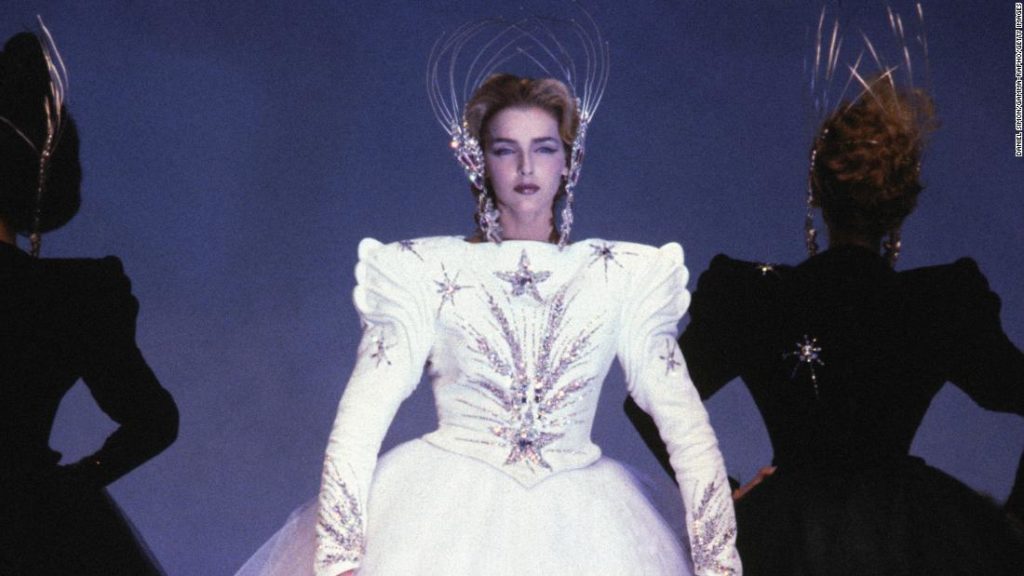The 1960s space race was more than a measure of scientific progress. The anticipation of this next stage of humanity left an indelible impression on culture, too.
President John F. Kennedy’s vision of man reaching the moon soon spawned a throng of TV shows and films — including cartoon sitcom “The Jetsons” and the “Star Trek” franchise — all of which looked to cater to America’s newfound interest in space travel.
Whether it was a chain-mail shift dress, a bulbous helmet or a pair of stark white boots, the sartorial legacy of the ’60s and ’70s was defined by a space-race exuberance. But even decades after we first set foot on the moon, the cosmos has remained a mainstay of inspiration for a variety of fashion houses.
Pierre Cardin

Pierre Cardin helped spearhead the space-age aesthetic with an array of ensembles in silver vinyl. Credit: Keystone/Hulton Archive/Getty Images
André Courrèges

A trained civil engineer, André Courrèges used his mathematical know-how when constructing garments. Credit: Kurita Kaku/Gamma-Rapho/Getty Images
André Courrèges released his Moon Girl collection, including white go-go boots and tall, spherical hats, in the spring of 1964. The late designer used high-shine PVC to construct stiff A-line skirts that held their own when twisted and contorted in fashion shoots. His interest in intergalactic glamour only grew from there. Three decades later, Courrèges was still sending space-inspired looks down the runway, as pictured here at an April 1993 show in Kyoto, Japan.
Paco Rabanne

Paco Rabanne’s early sci-fi designs made models look like they were dripping in metal. Credit: AFP via Getty Images
For many designers, the space race meant experimentation. Spanish designer Paco Rabanne was no different, fashioning mini shift dresses and matching headgear out of unusual materials like chain mail. Rabanne’s now notorious chain-mail creations made his models look like extraterrestrial warriors — dressed in body armor that was equal parts 16th-century knight and futuristic dancer.
Reed Crawford

Reed Crawford showed the “Dollar Princess” hat at a fashion show produced by the associate members of the Incorporated Society of London Fashion Designers. Credit: George W. Hales/Hulton Archive/Getty Images
Helmet-hat hybrids were key features of ’60s space-age style. At a London hat show in 1966, the late British designer Reed Crawford debuted the “Dollar Princess” hat, a half-visor, half-space-helmet creation that looked distinctly futuristic — despite being made from silver milk bottle tops.
Thierry Mugler

Thierry Mugler took a more ethereal approach to cosmic style and made feminine gowns fit for a space princess. Credit: Daniel Simon/Gamma-Rapho/Getty Images
Givenchy

The Givenchy Fall-Winter 1999-2000 collection spoke to a certain anxiety about the new millennium. Credit: Pierre Vauthey/Sygma/Getty Images
Dior

John Galliano took his bow while wearing a Dior Haute Couture spacesuit in 2006. Credit: Toni Anne Barson Archive/WireImage/Getty Images
Moschino

Moschino gave a new meaning to the space-age ’60s. Credit: Catwalking/Getty Images
Chanel

At Paris Fashion Week Womenswear in 2017, Chanel wowed audiences with a branded rocket. Credit: Bertrand Rindoff Petroff/French Select/Getty Images
Commes des Garçons

Rei Kawakubo took a deconstructive approach to intergalactic fashion. Credit: Catwalking/Getty Images
Iris van Herpen

Iris van Herpen’s Haute Couture show in 2019 was filled extraterrestrial-looking creations. Credit: Vittorio Zunino Celotto/Getty Images
Balmain

Models carried duffel bags and suitcases as they marched down a luminous catwalk that looped around the moon. Credit: Balmain
You may also like
-
Afghanistan: Civilian casualties hit record high amid US withdrawal, UN says
-
How Taiwan is trying to defend against a cyber ‘World War III’
-
Pandemic travel news this week: Quarantine escapes and airplane disguises
-
Why would anyone trust Brexit Britain again?
-
Black fungus: A second crisis is killing survivors of India’s worst Covid wave

